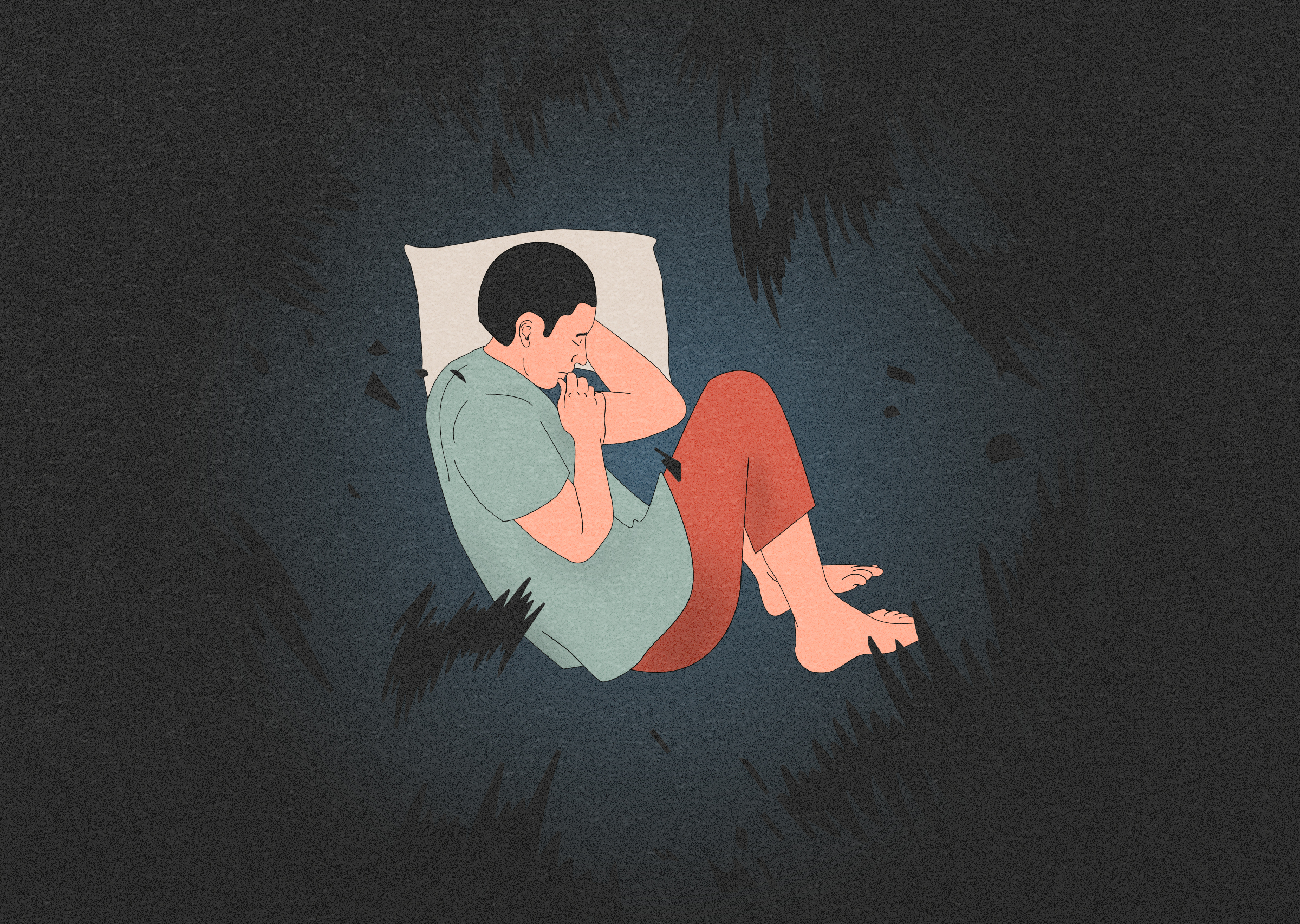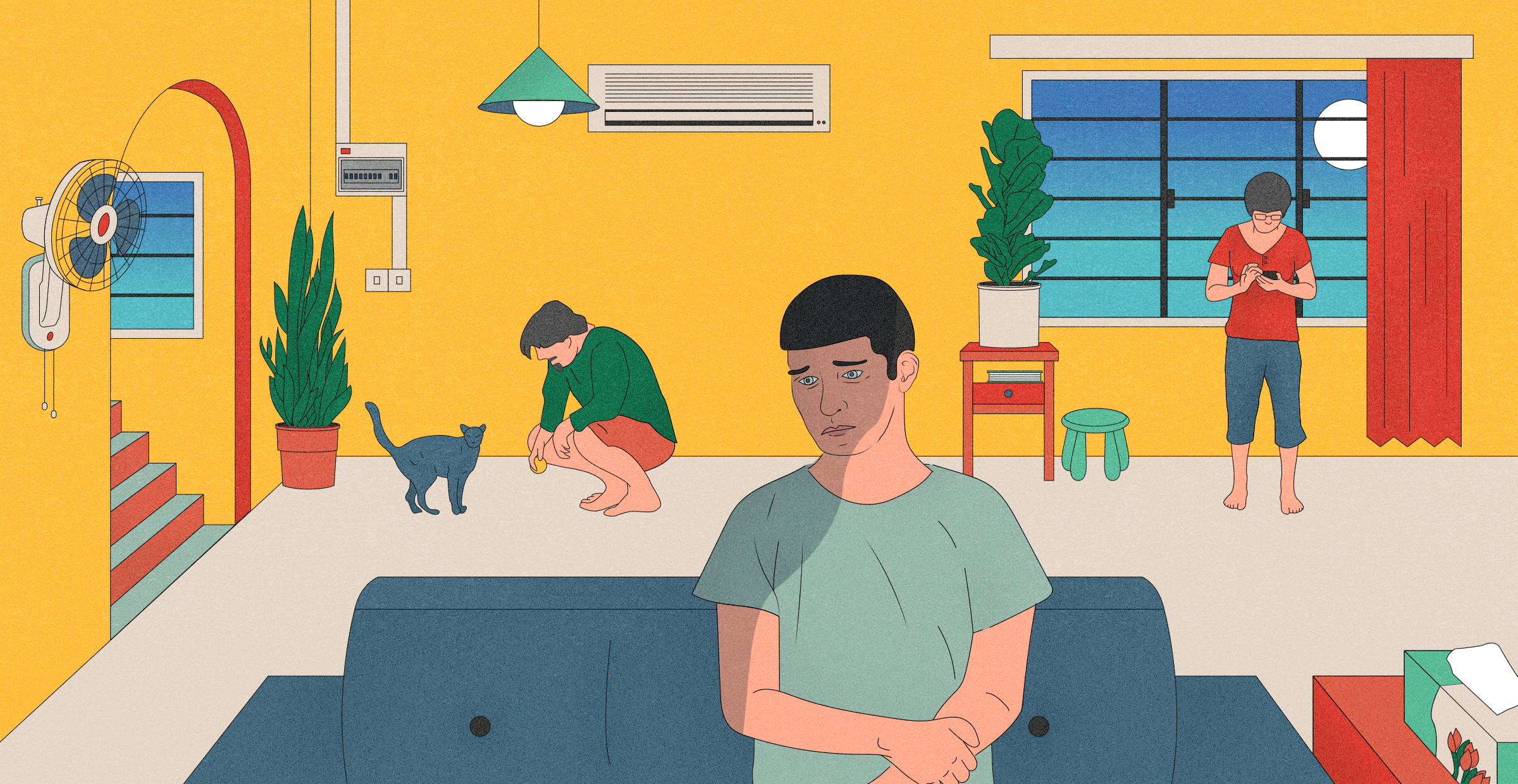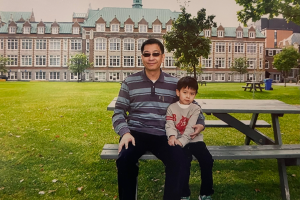In collaboration with CHAT, Thriving in Transition is a series dealing with how we make meaning of our individual experiences and emotions through finding solace in the support of others, no matter how daunting it can be to reach out. After exploring what loneliness looks like among Singaporean youth, today we dive deep into the spectrum of suicidal thoughts.
All illustrations by Jasmine Ho for RICE Media
Hey Ma and Pa,
It’s me, your only son. You know, the son who used to post out-of-context My Chemical Romance lyrics as Facebook status updates? The same one who works in a job you don’t really understand but politely nod when I talk about Google Analytics and audience growth strategies?
Don’t worry, I’m not writing to you today about how we can intrinsically coordinate goal-oriented mindshare to promote technically sound vortals (we can discuss it at a later date).
But I do feel like I owe it to my life-givers to disclose something that’s been on my mind for decades: I’m not actively suicidal, but I’m indifferent to being alive.
I’m not okay.
To be honest, I don’t really know when it started. There was the typical emo phase in secondary school, when it seemed like every Silverstein or Funeral For A Friend song was about me. There was the angsty self-destructive phase in my 20s, when spending nights out meant I could keep overwhelming emotions (the ones that made me feel like my heart could explode) at bay.
I honestly thought I’d never survive my 20s. Three years since turning 30, I’m surprised I’ve lived this long — and I’m surprised that the thoughts haven’t exactly gone away.
It’s a complicated coexistence with a duality: not interested in being alive but not wanting to die.
A Dead Letter Marked Return to Sender
This thing I’m wrestling with has a name: Passive Suicidal Ideation. But first things first — don’t worry, I’m not making any plans to off myself.
Suicidal ideation exists on a spectrum. As a society, we tend only to focus on those who actively make plans to off themselves. And rightfully so! Active suicide risks should be prioritised. But when we don’t talk about passive suicidal ideation, we leave many people out of the conversation.
On one end of the spectrum, there’s passive suicidal ideation, where people like me hold notions about dying without any intention to act on it. On the other, there’s active suicidal ideation, a grimmer prospect that involves intentional thoughts and concrete plans to die.
Here’s the thing: It’s easy to quantify suicides with statistics — 452 cases in 2020, Singapore’s highest count since 2012. But it’s hard to measure how many others are dealing with passive ideation. Most of us keep these thoughts to ourselves.
It’s mostly because of fear really, I certainly don’t want you or anyone else to walk on eggshells around me if I make it public. There’s the shame too: Why am I harnessing destructive thoughts despite things going great in my life?
With this internalised shame comes the mystery of just how common passive suicidal ideation is. The magnitude of the issue isn’t as well known when it’s not a mainstream concept.
Will time trigger this passivity into active ideation? What’s the root cause? Maybe it’s an ingrained, patterned response to pain, social rejection and loneliness during my youth. I mean, it’s normal enough to feel the blues every once in a while, but it sure is odd to harbour fleeting thoughts of killing myself every now and then for over a decade. And I haven’t learned how to tune them out.
The Quiet Things That No One Ever Knows

I admit, there’s a reason why I’d rather tell you about my predicament through a letter than actually talk face to face. It’s hard to find the words to say out loud over frank conversations — tough, sensitive conversations that we never really had before because… that’s just how most families in Singapore roll.
If we’re not even having frank conversations about our emotions with one another, imagine how hard it is to broach the subject of suicidality. Much less the complexities of living a functional life with suicidal thoughts.
Also, it’s tough to explain why. You gave me a pretty good life in a house filled with love and anything I would ever need.
But I do remember a time in my 20s when I tried to bring up my suspicions about having a schizoid personality disorder. You brushed it off with advice to simply “pray more”.
I don’t blame you for anything, of course — you probably didn’t know how to respond. Lacking nuanced discussions about mental health in school and society, none of us knew.
If it’s difficult to imagine what it’s like living with passive suicidal ideation, just think of it like ocean waves. The severity of my thoughts has its ebbs and flows; crashing hard on some days, calm waters on others.
One analogy that struck a chord was made by Anna Borges for The Cut. It’s like living in an ocean, a life of treading water. Some days are good, where the clear skies and smooth water prove to be pretty chill. Other days, it’s stormy weather and the waves overwhelm you.
Either way, there is that lingering knowledge that you might drown one day.
Like Anna, I’ve become adept at treading. But there have been storm-filled times when the temptation to stop staying afloat seemed particularly seductive. Days filled with a sense of worthlessness from failing to meet self-imposed expectations and the expectations of others — an undertow that threatens to pull you underwater.
I’ve fantasised about getting a one-way ticket to Iceland and freezing to death on a glacier. Imagined getting into a really bad accident while riding my motorbike on a highway. Dreamt of ways to fall asleep and never wake up again.
On other days when I feel fulfilled and content with myself, I’m simply floating on calm waters. No dark fantasies; just wanting to live long enough to catch Dr Strange in the Multiverse of Madness or finally conquer Elden Ring. It’s not my time to die yet — my cats need someone to clean up their litter box after all. I still want to travel abroad with the missus, because I promised her we would after Covid blows over.
And when I focus on the people that need me around (like you, Ma and Pa, who would be shattered if I checked out from life early), the overcast dissipates a little.
I’m doing better these days, I promise. I’ve lived long enough to know that things do get better in the horizon, past the choppy waters. With age comes a maturer perspective on life: Everyone goes through hard times, it’s how we deal with them that differs.
Don’t worry, I’m no longer putting up cringeworthy emo-laced aphorisms as subconscious calls for help anymore. Friends gently pushed me into a life beyond (literally) sitting still and I found healthy avenues to gust away the dark clouds above my head. Have you tried going for night jogs or bouldering? The endorphins really clear up your mind — and that sense of self-worth gets better when you notice your performance improving each round.
During times when the rain doesn’t let up, it’s also good to know there are always avenues to turn to.
Letters To You

I wish I could tell you that there’s a pill to swallow or a program to go through to make it all go away. I also wish that I feel more perturbed living with this issue.
As fine as I’m doing right now— even with fluctuating desires of ending my life — it’s still an ominous desire. Studies have shown that without clinical intervention, there’s still the risk that passive suicidal ideation can turn active one day, a day when I’ll decide to let the waves pull me under.
Even in writing this letter, I’m feeling the embarrassment of how you or other people might change how you talk or act around me. You know how loaded the word ‘suicide’ is — there’s a good chance that alarm bells are already ringing in your head. Cue the Samaritans of Singapore hotline and awkward questions about how I’m feeling right now.
I guess I’ve always been worried about being honest about my experiences. Maybe I’m worried about the overreactions. Imagine if we casually talked about the topic of suicide; perhaps those who’ve been hiding their passive suicidality can cope better. I’m hoping this letter can serve as a lighthouse for others like me when they realise they’re not alone in the pitch-black ocean.
What I know is that it often helps for us to have a frank conversation with people we care about what we’re going through. It helps to know that our loved ones will show up for us with lifebuoys when we’re struggling to keep our heads above water. Check in with me through text or calls at random times —knowing that you’re keeping me in mind does wonders for my self-worth. Trust me, just asking how my day or week is going reminds me that my loved ones do care.
We can work out an emergency plan like hotlines to call and A&E services to look out for when dormant desires turn deadly. Before that though, I’m hoping that the family can sit down one day where you can listen about my lived experience. It’ll be hard at first for me to talk openly about it (there will be tears). But once we get through that barrier together with words of affirmation and reassurance, maybe we can look through some ways I can get better with professional help.
Ultimately, it’ll be great for you — and other parents out there — to recognise that mental health is a knotty issue that can’t be fixed with simple advice. Recovery isn’t always linear; it’s an ongoing process.
Like suicidality, it’s not black and white when it comes to getting better. But we can all learn how to float on slowly to safer shores.
Helplines in Singapore
Samaritans of Singapore (SOS) Crisis Helpline
Call: 1-767
Institute of Mental Health Helpline
Call: 6389 2222
National Care Hotline
Call: 1800 202 6868
Singapore Association of Mental Health (Toll-Free Counselling Hotline)
Call: 1800 283 7019
ec2 online counselling
Visit: www.ec2.sg
CHAT
Visit: www.chat.mentalhealth.sg
Shine Children and Youth Services’ ResiL!ence
Visit: www/shine.org.sg/resilience
Limitless
Visit: www.limitless.sg
Care Corner Insight
Visit: www.carecorner.org.sg/insight







